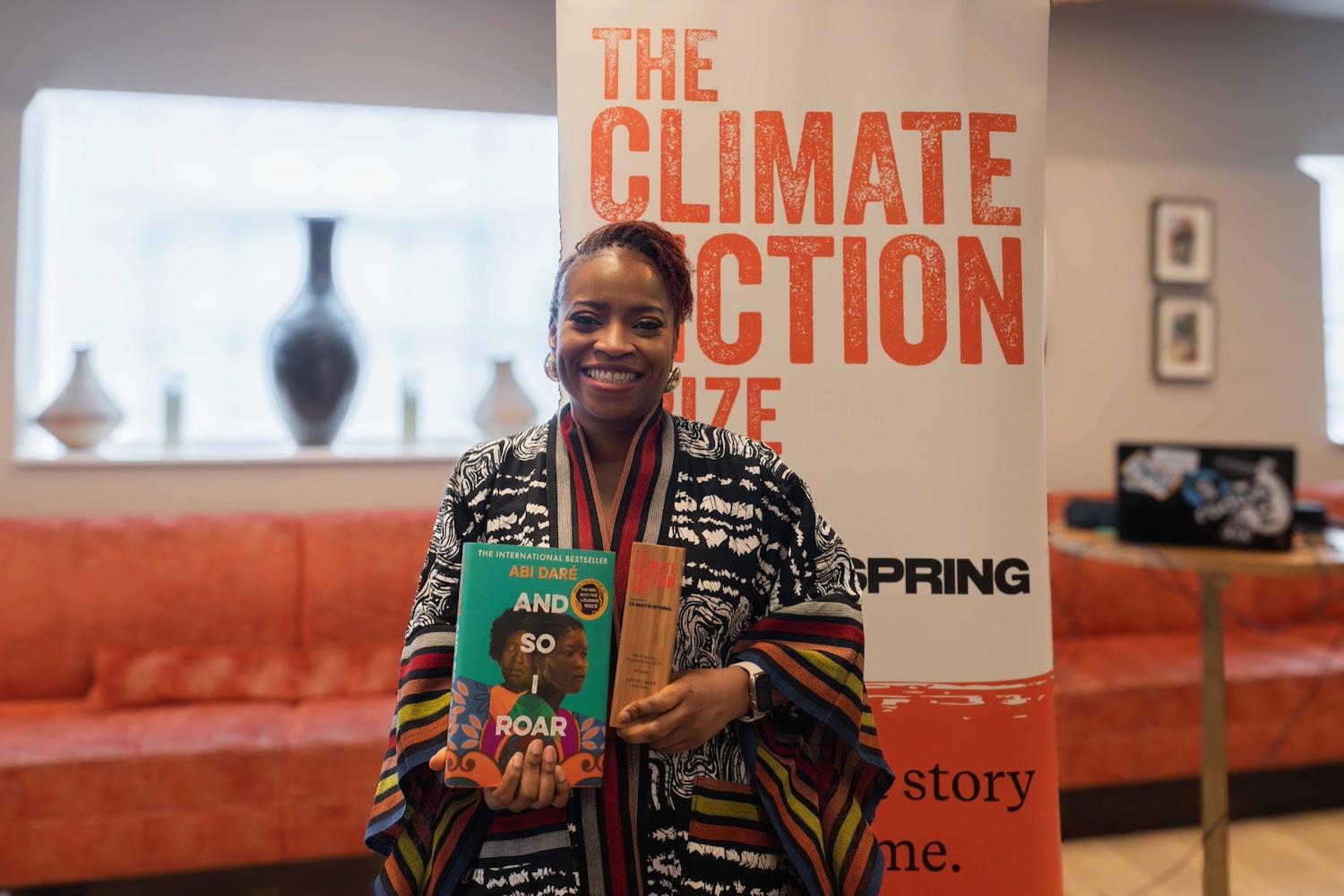
Abi Daré, winner of the very first Climate Fiction Prize for her novel “And So I Roar.” (Image:Heyse Ip/Climate Fiction Prize)
This story about climate fiction is part of The Solutions Effect, a monthly newsletter covering the best of solutions journalism in the sustainability and social impact space. If you aren't already getting this newsletter, you can sign up here.
Climate change, in one way or another, worked its way into our stories long ago. Many trace the first mentions in modern novels and movies back to the beginnings of the science fiction genre over a century ago, which often told tales of postapocalyptic worlds and humanity’s persistence. As early as a couple of decades later, science fiction readers would come face-to-face with explicit climate disasters bringing an end to life as the characters knew it.
My first encounter with the phenomenon was the 2008 animated film about the lovable, Earth-cleaning robot Wall-E. It was a childhood favorite of mine, though at the time, I’m not sure I truly understood the gravity of the message.
Climate fiction picked up steam as its own genre more recently, thrust into the spotlight by new stories like the buzzy 2021 film “Don’t Look Up,” the blockbuster video game turned television series “The Last of Us,” and a dedicated list of books racking up thousands of reviews on the popular social platform Goodreads.
These stories build on the genre’s science fiction roots, exploring how climate change might impact our world, our relationships and us. Occasionally, characters live in a seemingly utopian society long after the initial disaster. More often, they struggle to survive in a desolate dystopia. The state of the world is left to each author’s speculation, but regardless of the setting, every story engages with climate change and our reaction.
The first Climate Fiction Prize was awarded earlier this year. Backed by the storytelling organization Climate Spring, the literary award celebrates stories showcasing the impacts of climate change and society’s response. The first award was presented to Nigerian author Abi Daré for her novel “And So I Roar.” It follows women and girls in Nigeria as their lives are changed by environmental collapse.
“For societies to fully grasp the climate change threat and to embrace its solutions, we need better stories,” the Climate Fiction Prize website reads. “It’s not enough for audiences to know about climate change; they need to see an uncertain future and understand that change is urgent but possible. Many of us already see tackling climate as important; but we don’t always know how we should respond. Fiction can help us imagine what change can look like.”
The emphasis on exploring solutions, whether intentional or not, puts climate fiction in the solutions storytelling realm. But the growing stir around the genre left me wondering whether these books are a solution in themselves. Taking a glimpse into a future where, despite the worst-case scenario, people find ways to fight the problem we’re staring down surely inspires hope, right? Early research says maybe.
The first study on whether climate fiction narratives that prompt both hope and fear impact climate action was published earlier this year. Researchers gave snippets of a popular climate fiction novel to readers from India and the United States who were already concerned about the climate. Fictional stories of people with difficult-to-achieve aspirations, but aspirations nonetheless, were found to instill fear and hope in some readers, which can effectively prompt the desire to take action.
It’s likely that the climate impacts in books demonstrate the severity of the problem, invoking the reader’s fear and a subconscious judgment of whether they can address the threat in real life. Then, when the actions of the characters show that the problem can be addressed, the reader is more likely to feel that they, too, can take meaningful action. This approach was more effective with readers from India. Readers from the U.S. were spurred to action by dystopian novels, which emphasize fear and offer little to no hope.
The overall impact was small, and more research is needed, but the fact that climate fiction books branching away from the oh-so-negative norm can lead to action is noteworthy.
“Fear-inducing narratives have been dominant in the climate space, but it’s good for attention, not for action,” Jagadish Thaker, one of the study’s authors, told Mongabay. “A combination of the two (hope and fear) will most likely result in heightened concerns matched with beliefs that one has power, individually and collectively, to address them.”
A study published in 2018 backs Thaker up. It found that most climate fiction novels led readers to feel intensely negative emotions about climate change, as the most popular theme in the genre is dystopian. Though books detailing catastrophic consequences reminded people of the severity of the problem, the negative storylines also stood in the way of inspiring them to take action. Study participants used terms like “doomsday scenario” and “foreboding” to describe what they read. One respondent said a book made them “feel that climate change is not only real but such a big problem, we may not be able to solve it.”
A 2020 study suggests that the impact of climate fiction on readers’ beliefs and attitudes only lasts about a month, but that doesn’t mean it can’t be effective. Repeated exposure to these topics can lead to longer-lasting change, so authors of the genre still have a chance to turn that negative narrative around and encourage readers instead.
Projects like the Climate Fiction Prize, the annual Imagine 2200 contest for short stories detailing both climate struggles and solutions, and the Climate Reality Check that evaluates how well climate change is represented on the big screen prove to me that other people want stories featuring both sides of the coin, too.
“These are the kinds of stories that really help us grapple with this, and find courage and learn how to survive both on an emotional level and actually going through horrible disasters,” Anna Jane Joyer, founder of the storytelling organization behind the Climate Reality Check, told TriplePundit earlier this year.
As an avid science fiction reader who has yet to intentionally dip their toes into the climate-specific genre, I plan to test this theory out for myself, starting with the shortlist for this year’s Climate Fiction Prize. Do you have a climate fiction recommendation? Tell me about it here.

Taylor’s work spans print, podcasts, photography and radio. She brings her passion for covering social and environmental issues through the lens of solutions journalism to her work as assistant editor.














